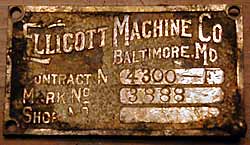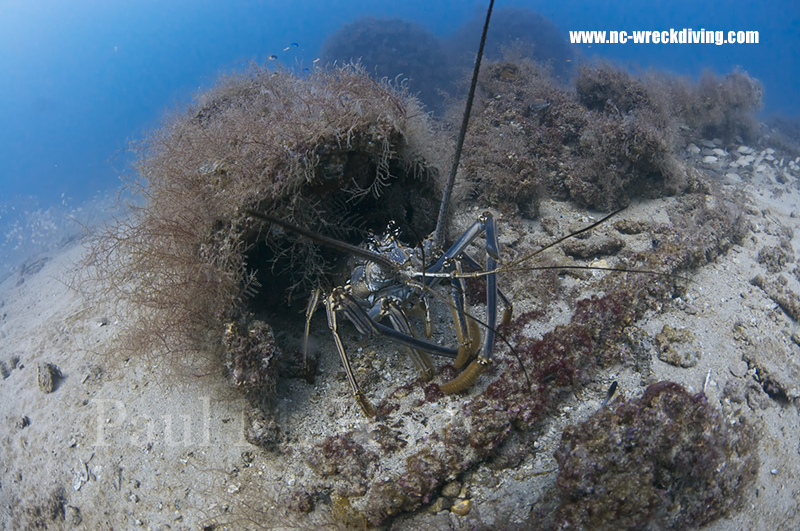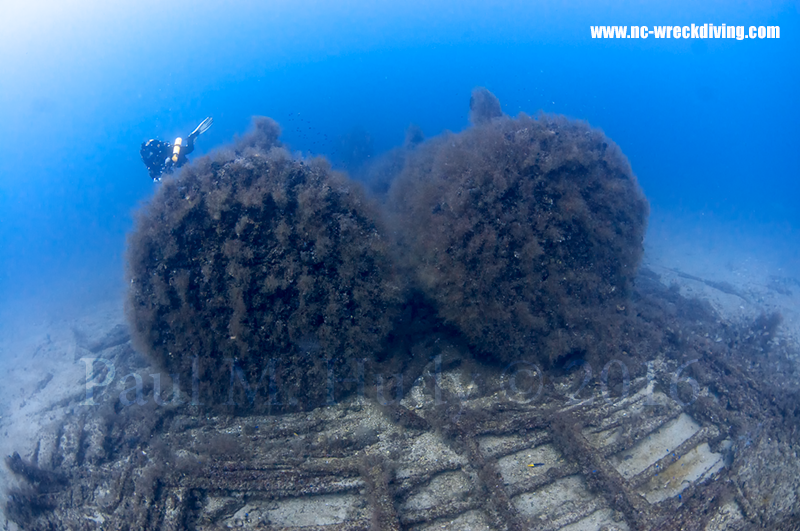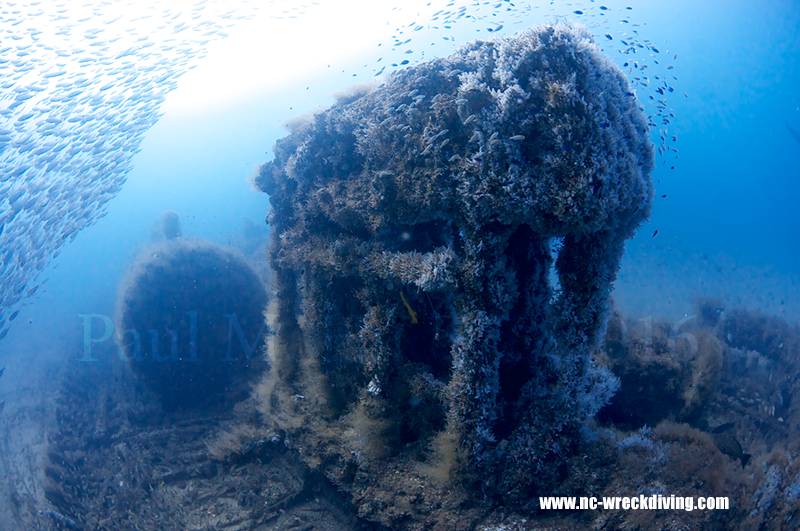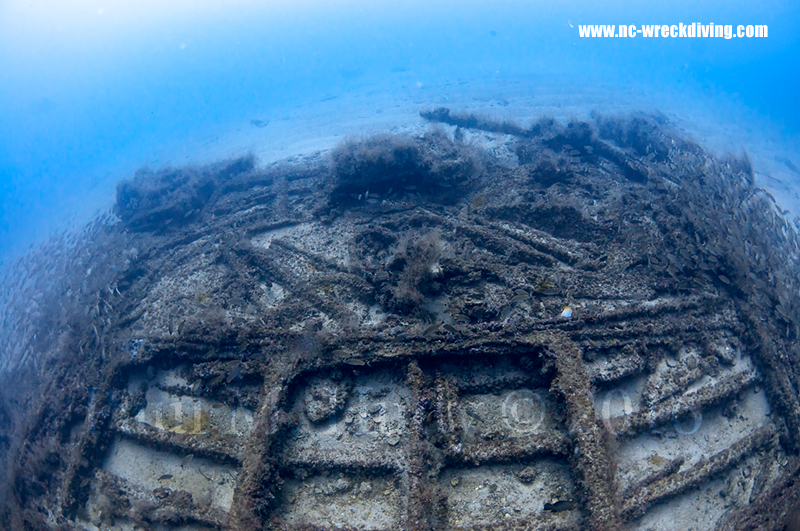|
|
SHIP HISTORY:
|
It had been suspected for a while that the "lobster wreck" was a dredge. In August, 2000, there was a confirmation of that suspicion plus a probable identification. Bryan Tate, of Wilmington, NC, found a windlass/winch from the "lobster wreck". With two lift bags, he and dive buddy Steve Lewis recovered the piece from the wreck. On the winch, Bryan found a name plate for the Ellicott Machine Company. The Ellicott Machine Company is still in business and after some correspondence, a company representative matched the contract number and reported to Bryan that the winch was originally installed on the dredge, Porta Allegra. also known as "No. 4300" (see plate recovered by Tate).
[UPDATE] When researching another shipwreck in 2017, Michael Barnette discovered a newspaper report of December 15, 1909, Baltimore, MD, referencing the sinking of Dredge 4300, with the same details, dates and particulars of the tragedy, and identified it as the sinking of the dredge Port Ancon. (UPDATE: Ellicott Machine closed its doors in 2002 after an international deal with Thailand fell through, but appears to have been reconstituted as Ellicott Dredges) |
|
|
"Ellicott Machine Co., Baltimore, Md.,
Contract No. 4300-F
Mark No. 3888
Shop No"
Brass plate from the windlass recovered by Bryan Tate in August 2000. (Photo: Byran Tate)
|
The Dredge 4300 was built around 1908 and was outfitted with a 20 inch cutter. Company records do not indicate whether this dredge sank or whether this winch has been reinstalled on another dredge, but there is some documentation in a Federal Reporter about a negligence/wrongful death claim surrounding the sinking that seems to shed light on the fate of the dredge No. 4300. |
| The dredge was built under contract between Ellicott and the Isthmian Canal Commission to be used in building of the Panama Canal. The contract price was $158,000 paid in installments. Only the final payment was due, but it hinged on the safe delivery of the dredge to Panama. Ellicott had full responsibility for that delivery. Following approved and customary practice, Ellicott prepared No. 4300 for its voyage to Panama by building timber bulwarks outside of and around the dredge house. This was to protect the house for any heavy seas that may wash aboard. The dredge carried a crew of 7 (master, engineer and 5 seaman) and a metal lifeboat weighing 1200 pounds and having a capacity of 25 men. The lifeboat was stowed on blocks on the after main deck. There were bags of coals stacked around the lifeboat. It was a point of conflict in the negligence case just how tightly the coal was stacked around the lifeboat and whether the use of the lifeboat in an emergency was thus rendered impractical. |
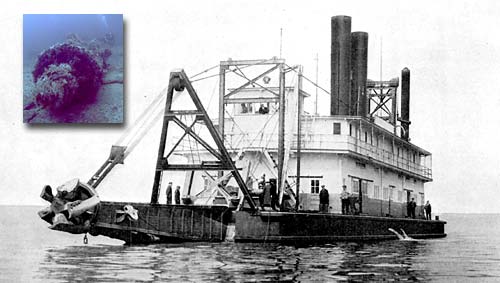 |
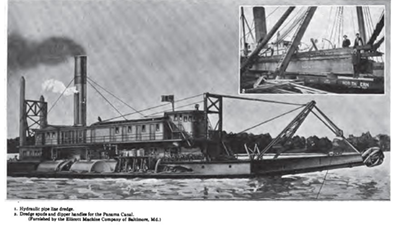 |
| Steam dredge, contemporary of the Porta Allegra/Port Ancon, with 20" cutter (Photo: Ellicot Machine Co.) INSET: 20" cutter of the Porta Allegra as it appears today on the ocean bottom. |
Historic image of a contemporary of the dredge type. |
| Dredge 4300 left Baltimore on December 9, 1909 in tow of the tug Tormentor. The voyage was under good weather until the afternoon of December 12 when the dredge was located somewhat south of Cape Lookout. At that point, the wind shifted to the S and SE and grew in force from the afternoon of Dec 12th until 4 pm on Monday the 13th. About a hour before daybreak on Monday, Dec 13, a tremendous crash was heard on the dredge. The bulwarks had crashed in and the house was smashed. The Master ordered the crew to run to the lifeboat. The six crew members surrounded the life boat and tried to launch it, but were unable to move it more than 6 inches due to the coal bags. The Master went to the upper deck and blew four long and four short blasts on the whistle, turned the search light up vertically, and waved a white light. While the men were around the lifeboat, the bow of the dredge went underwater, followed almost immediately by the stern. Two of the crew tried to jump in the lifeboat as the dredge went down, but the lifeboat was caught up in the wire ropes which supported the dredging apparatus and destroyed. |
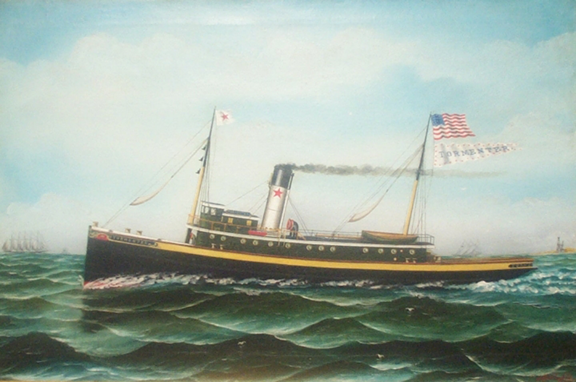
|
| The tug Tormentor
|
| The crew of the tug testified while they had been keeping close watch on the dredge, they saw no indication of trouble or signals until lights of the dredge completely disappeared and the tug started to act like it was anchored from the stern. They ran back to the hawser, realized the dredge had sunk and immediately cut the hawser. The Tormentor maneuvered to stay in the immediate area until daylight. At daylight, 3 were discovered still floating on the dredge wreckage and successfully brought on board the tug. The remaining four, including the master, the engineer and two of the seaman were never recovered and presumed drowned. |
|
| DIVING NOTES: |
| Diving Depths: 115-125 ft. |
| Current: none to slight |
| Visibility: 50+ feet |
| Summer Temperature: High 70s to lo 80s |
| Points of Interest: Four boilers and large steam engine, bow and stern anchors, derrick posts and dredge auger. Lots of tropical marine life. |
| Fish/Animal Life: There seems to be an abundance of tropical marine life on this wreck. Lots of angelfish and other small tropicals as well as lobster (but of course!) and hogfish. The lionfish (see below) is also a frequent and recent resident to this wreck. |
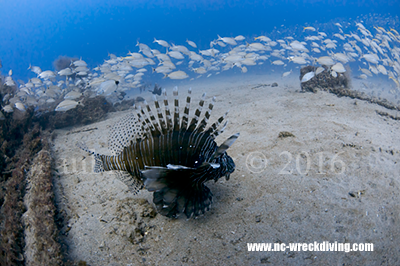
|
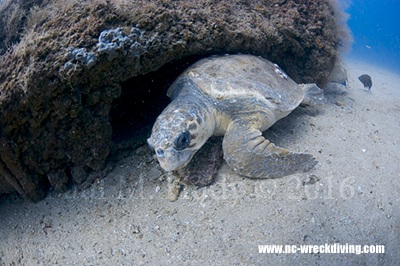
|
|
Numerous lionfish — Pterois volitans — now make this wreck home
|
Loggerhead turtle tucked under the dredge head
|
Description: I first dove this wreck in the mid/late 80's on the Whipsaw out of Wrightsville Beach, NC with the late Captain Ed Wolfe. As far as I know, Ed, an "old-salt" fishing captain, was the first to take divers to this site. It is referred to as the "Lobster Wreck" because on the opening day of the old lobster season (before March 1 and after August 6), at least one dive boat would make the long trek to the site and come back with dozen or so large spiny lobster. Since the lobster season is now year-around with a two-per-diver limit, and the wreck is so far out, this wreck is visited a bit less often.
The wreck has not been identified, but it appears to be some type of dredge. A date of 1909 on a steam gauge recovered by Gordon Smith offers the only clue as to the time of its sinking. [See update on identification above] The wreck site is rectangular in shape and contiguous over its length. The wreck is quite small and appears to be somewhere between 150 and 200 feet in length and less than 100 feet wide (UPDATE: more likely smaller in the 150x50 range). There are four boilers and a large steam engine which were used to power the dredge. These offer the highest point of relief on the wreck. Aft of the engine, there are two large posts rising up from the wreck. These were used to support the dredge derrick and deck structure. The dredge auger is extending out from the "stern" of the wreck and is lying out in the sand much like a propeller shaft. The wreck can be easily circum-navigated in a single dive. In spite of its small size, the "Lobster Wreck" is one of the more beautiful dives off of North Carolina and has a lot to offer both photographer and hunter. Since the mid-1980s, the coastal waters of NC have been the home of "invasive" species of fish normally only seen in the tropical Pacific — Pterois volitans, more commonly know as a lionfish. It is believed that humans introduced these "aquarium" fish into the Atlantic and scientists have been tracking the fish as they spread from Florida, into the Caribbean and north to NC an beyoond. The "lobster wreck" was one of the first NC dive sites lionfish became established in large numbers off of NC and they seem to have maintained a pretty consistently large resident population. I have seen dozens of dozens in a single dive. |
